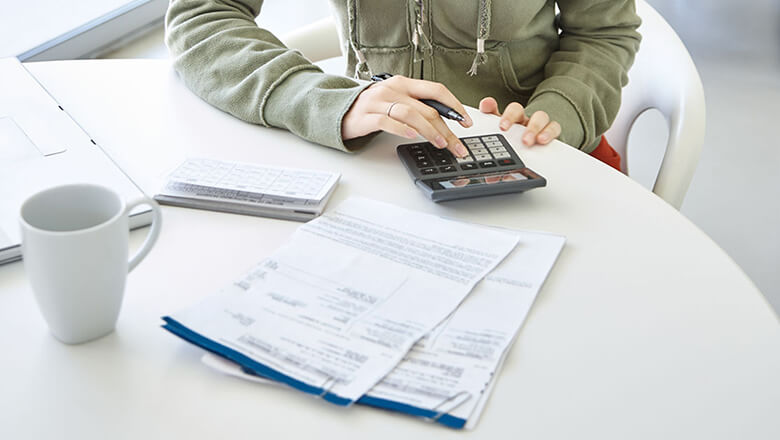Using the Debt Avalanche Method of Paying Off Debt
Debt is a slippery slope. You can be doing just fine when an unexpected bill starts a slide. Maybe you use a credit card or three to keep up for a while. But one setback — like major car repairs — throws you off balance again, and eventually debt begins to swallow you up.
But there’s good news. First, you’re not alone. Second, millions of people like you have dug themselves out of debt using the Debt Avalanche Method. This debt reduction strategy focuses your efforts on the debts with the highest interest rates. Keep reading to learn the advantages and disadvantages of this strategy, as well as some proven alternatives for paying off debt.
How the Debt Avalanche Method Works
First, make a budget. Determine exactly how much money you have coming in each month and how much goes out to household bills. Find ways to trim the fat from anything you can — dinners out, streaming services — so you’ll have more cash to pay toward that smothering debt. If you need help, here’s a guide to the 70-20-10 rule of budgeting.
Then make a list of all your debts. Start with the loan or credit card that has the highest interest rate, and work your way down to the one with the lowest interest rate. Don’t pay any attention to which one has the highest balance or the highest minimum payment. The Avalanche Method is all about interest rate.
Continue to make the minimum payments on all your debts, but put anything you can (bonuses, tax refunds, that $20 your grandma stuck in your pocket) toward paying off the high-interest debt at the top of the list.
Now we’ll fast-forward to the glorious moment when the first debt on your list is paid off. Congrats! Cross it off and move to the next debt on your list: This should be the one formerly known as the second-highest-interest-rate debt, now the highest.
Roll whatever payment you were making on the first debt into the second debt, adding it on to the minimum payment. When that debt is paid off, do the same with the third on the list. As you continue paying off outstanding debt, you should have more and more money to put toward the next target balance. Keep going until you’ve plowed through each debt on your list and can declare yourself debt-free.
Advantages of the Debt Avalanche Method
Fans of the Debt Avalanche Method laud its efficiency. The most expensive debt is ditched first, which can be a big money saver. And the amount of time it takes to get out of debt overall is cut too, because less interest accumulates every month.
Remember, the compound interest (interest on interest) that you love in your savings account can crush you when you owe money. Although compounding periods vary from daily to monthly to annually, depending on the type of debt, credit card balances are typically compounded daily.
That means every little purchase you make and carry over months and years is probably costing you way more than you want to think about. And if you miss payments, the interest rate you’re paying will likely increase, costing you even more.
If you need help keeping yourself in line, check out the minimum payment warning on your monthly statement. It informs a cardholder just how long it will take to pay off a balance if only the minimum monthly payment is made, as well as how much will need to be paid each month to pay off that balance within three years. The total dollar amount paid in each scenario is also disclosed.
Downsides to the Debt Avalanche Method
Using the Avalanche Method to pay off debt isn’t necessarily a good fit for everyone. The method is great for disciplined, analytical thinkers who get excited by the knowledge that they’re playing the long game.
However, the Avalanche approach might not provide enough incentive for those who are motivated by feelings as well as logic. If you need the psychological boost from small wins to stick to a plan, it can be a tough ride.
Another downside to the Avalanche is that it assumes paying off debt as quickly as possible is always the right thing to do. But there are other factors to consider, like your credit score.
If you’re contemplating purchasing a home or car in the near future, or taking out some other kind of loan, it may be worth running the numbers and looking at how your paydown plan will affect your credit utilization ratio and improve your ability to qualify for a lower interest rate.
To make the Avalanche Method a success, it helps to be the type of person who is self-disciplined, self-motivated, self-aware, and capable of celebrating self-made milestones.
Which Debts To Include in a Debt Avalanche
It’s important to know which sort of debts should be included in a debt payoff strategy — and which ones you should leave out. When making your list of debts from high to low interest, include the following:
• Credit cards
• Personal loans
• Student loans
• Car loans
• Buy Now, Pay Later (BNPL)
• Medical bills
With Buy Now, Pay Later, borrowers typically pay no interest as long as they make their payments on time for a designated period. So keep making those payments, but don’t worry about putting extra cash toward your balance until that debt rises to the top of the list.
The same with medical bills. Doctors and hospitals generally don’t charge patients interest on outstanding balances. Make your payments as agreed, but reserve extra cash for the higher-interest debt.
Do not include your mortgage. Financial experts consider this “good” debt. One day, you may decide to put extra money toward paying down your mortgage principal, but for now, focus on your other debts.
Debt Avalanche Example
Below is the debt list for a hypothetical individual, Jane, with over $35,000 in debt. Note that these debts are in order of highest to the lowest interest rate. The balances and minimum payments are in no particular order.
| Debt | APR | Balance | Minimum payment |
|---|---|---|---|
| Credit card #1 | 23% | $3,000 | $35 |
| Credit card #2 | 18.99% | $4,000 | $40 |
| Credit card #3 | 15% | $5,000 | $50 |
| Car loan | 9% | $10,000 | $200 |
| Student loan | 4.99% | $9,000 | $78 |
| Buy Now, Pay Later | 0% | $1,000 | $166 |
| Medical bills | 0% | $3,500 | $292 |
Jane is paying over $800 a month just to keep up with minimum payments. But only making minimum payments won’t get you out of debt anytime soon. Fortunately, Jane found another $500 a month to put toward her first credit card. She’ll save big on interest as she pays down the balance. However, she’ll still need to pay another $800 a month on her other minimum payments.
Alternatives to the Debt Avalanche Method
The Avalanche is for rational thinkers. But when it comes to money — and life in general — humans tend to follow their gut. That’s why some people prefer the Avalanche’s more emotionally available cousin, the Snowball Method.
With the Snowball Method, the steps are much the same, but you start your list with the smallest balance and work your way toward the largest, disregarding the interest rate. The idea is that those first targets can be knocked down quickly, creating a sense of accomplishment that helps keep you on task until it becomes a habit.
But if the Avalanche and Snowball methods leave you cold, maybe you’ll find inspiration in a hot hybrid. This one’s called the Debt Fireball, an original SoFi strategy created to help people torch their expensive “bad” debt and move on to the things that matter to them faster.
The Fireball blends the best parts of the Avalanche (the cost savings and faster timeline) and the Snowball (the motivation and feeling of achievement). And it adds some flexibility for those who wish to prioritize saving and investing.
How the Debt Fireball Works
After making a budget and determining how much money is left over each month after paying for necessities, prepare to tackle your debts. Start by categorizing all your debt as either “good” or “bad.”
Like the Avalanche, this method is all about the interest rates. Debts with an interest rate of less than 7% are “good.” Debts with an interest rate higher than 7% are “bad.” For example, a student loan with a 3% interest rate would be good, while a credit card with a 21% interest rate would be bad.
Take the list of bad debts and put them in order based on their outstanding balances, from smallest to largest. Keep making the minimum monthly payment on all outstanding debts, but funnel any excess funds toward the smallest of the bad debts. For that one, pay the minimum plus whatever extra amount you can.
When that balance is paid in full, move on to the next smallest bill on the bad-debt list. Keep burning through those balances until all your bad debt is repaid. After that, keep paying off your good debt on the normal schedule while you also invest in your future. You can look at putting your money toward a financial goal, such as saving for a house, starting a business, going back to school, or retirement.
The Fireball is a debt management plan that’s built for real people. It appeals to a person’s practical side because it prioritizes high-interest debt. It organizes a payoff plan in a logical way and focuses on paying off one debt at a time. But it also can provide the psychological strokes some of us need to stay interested and dedicated to becoming debt-free. It turns the trek out of debt into a series of short hikes.
Recommended: When to Start Saving for Retirement
The Takeaway
Using the Debt Avalanche Method is a great way to pay off debt for disciplined, logical personalities who want to maximize their savings on interest. The Avalanche works by paying down the highest-interest debt first, regardless of balance, while making minimum payments only on other debts. It’s not for everyone, though, especially if your highest-interest debt is also your biggest balance. For folks who want to celebrate short-term wins to keep them going, the Snowball Method is a popular option. Instead of focusing on interest rate, borrowers prioritize the lowest balance first. The key to any debt payoff strategy is to know yourself and choose the method that feels right for you.
Another option for paying down debt is a personal loan. SoFi offers personal loans with low rates and no fees required. Whether you need to consolidate your credit cards or other high-interest debt, consider an unsecured personal loan to simplify your finances.
SoFi Loan Products
SoFi loans are originated by SoFi Bank, N.A., NMLS #696891 (Member FDIC). For additional product-specific legal and licensing information, see SoFi.com/legal. Equal Housing Lender.
Disclaimer: Many factors affect your credit scores and the interest rates you may receive. SoFi is not a Credit Repair Organization as defined under federal or state law, including the Credit Repair Organizations Act. SoFi does not provide “credit repair” services or advice or assistance regarding “rebuilding” or “improving” your credit record, credit history, or credit rating. For details, see the FTC’s website .
Financial Tips & Strategies: The tips provided on this website are of a general nature and do not take into account your specific objectives, financial situation, and needs. You should always consider their appropriateness given your own circumstances.
SOAD19025




